The Huawei Mate 8 Review
by Andrei Frumusanu on January 5, 2016 1:00 PM EST- Posted in
- Mobile
- Smartphones
- Huawei
- Cortex A72
- Kirin 950
- Mate 8
- CES 2016
Battery Life
Continuing to the battery life benchmarks we should expect the Mate 8 to perform very well, thanks to the high efficiency of the Kirin 950, an LCD screen as well as the 4000mAh / 15.2Wh large battery.
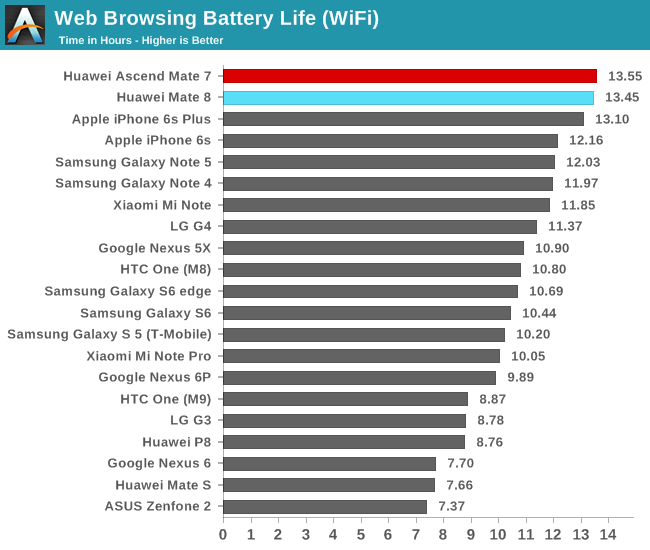
Starting off with our WiFi web-browsing test we see the Mate 8 just get short of 13.5h of battery life. The interesting comparison is here to last year’s Mate 7 as it seems the actually last just as much. This may point out that the screen efficiency measured in our display power testing was maybe correct and the Mate 8 is less efficient. Another aspect is that the Mate 8’s overall platform power consumption hasn’t seen much improvement and thus still represents a large barrier for battery life.
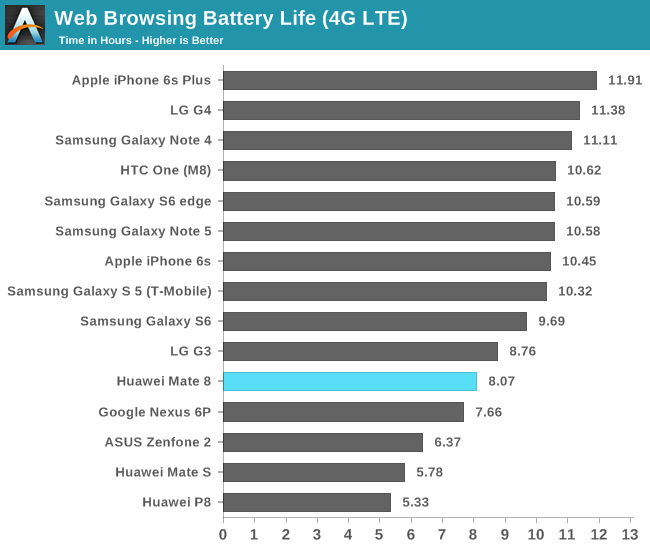
On the 4G LTE test we see that the Mate 8 loses out its advantage over the competition. Again I’m testing under rather mediocre signal conditions so it’s not a valid apples-to-apples comparison to devices reviewed by Joshua or Brandon, however when comparing it against for example such as the Nexus 6P which was tested under the same conditions we see that the Mate 8 faces a much larger battery life degradation going from the WiFi to the LTE test. The reason for this can only be that the Kirin 950’s modem and RF back-end just aren’t as efficient as Qualcomm or even Samsung’s.
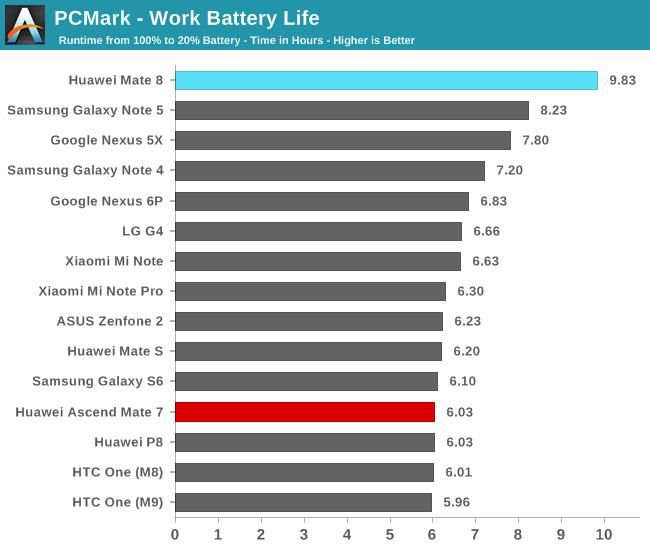
While the web-browsing tests didn’t represent a large improvement for the Mate 8, we see PCMark put the phablet as the current undisputed leader among high-performance devices. Here the difference to the Mate 7 is almost 4 hours, or around a 65% increase in battery life. The increase is most certainly linked to the new SoC’s power efficiency.
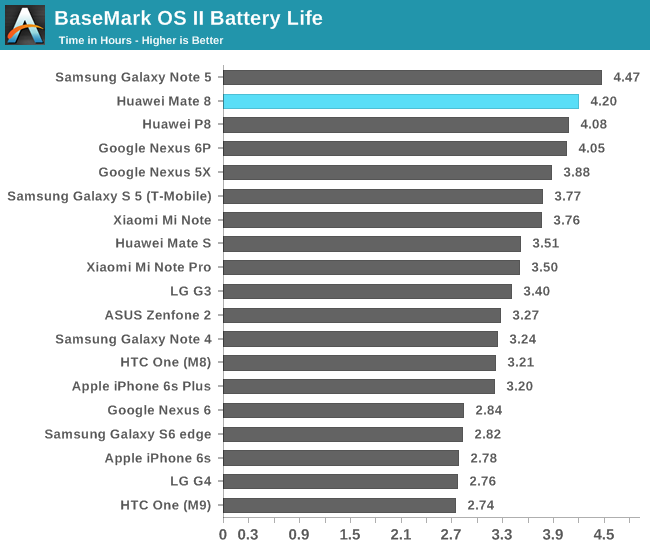
BaseMark OS II’s battery test is more of a maximum load type test that depends on the allowed maximum TDP of the phone. With a 15.2Wh battery and a runtime of 4.2h we see an average consumption of 3.6W, roughly the same amount of power that I saw that the device was able to sustain in our CPU thermal test.

Finally the GFXBench battery test shows that the Mate 8 doesn’t show very good battery life but this is a two-edged sword. As we’ve seen in the GPU section the SoC hardly throttles under heavy GPU load and thus retains its maximum performance for the duration of the test. Considering that the Mate 7 slowed throttled down to 9-10fps and the Mate 8 does not go under 40fps, it still shows that the Mate 8 is twice as efficient as the Mate 7 even though overall battery life is almost twice as short.
At 200 nits the Mate 8 averages an idle power consumption of 989mW and we saw that system load power for the T-Rex test is 3.64W. 3 hours battery runtime averages 5W of power, near the 4.6W we theorized. The small difference may be due to the overhead of actually running the on-screen test and thus also not able to show the DDIC’s savings thanks to PSR due to continuously changing screen content.
Overall I’ve been extremely impressed by the Mate 8’s battery life. In everyday usage this is the longest-lasting device I’ve had the opportunity to use. The Kirin 950’s efficiency is outstanding and is truly able to earn its place among the top for this generation. It seems the Mate 8’s limiting factors are related to the screen and general platform base power consumption, something that Huawei may be able to improve in future devices and thus get even better value out of the Kirin 950.
All being said, if you’re looking for a long-lasting device, you can’t go wrong with the Mate 8.
Charge Time
The Mate 8 advertises fast charging out of the box so that even considering it having a large 4000mAh battery, it should still be fast to fill up when in need. The stock charger is a 9V/2A (18W) unit. I’m not sure if the charging enumeration protocol is based on Quick Charge or Adaptive Fast Charging, but it was able to enable fast-charging on Samsung phones while the Mate 8 didn’t fast-charge on Samsung’s charger, meaning the Huawei charger is likely a Quick Charge unit and the Mate 8’s PMIC and voltage negotiation IC seems to only accept Quick Charge.
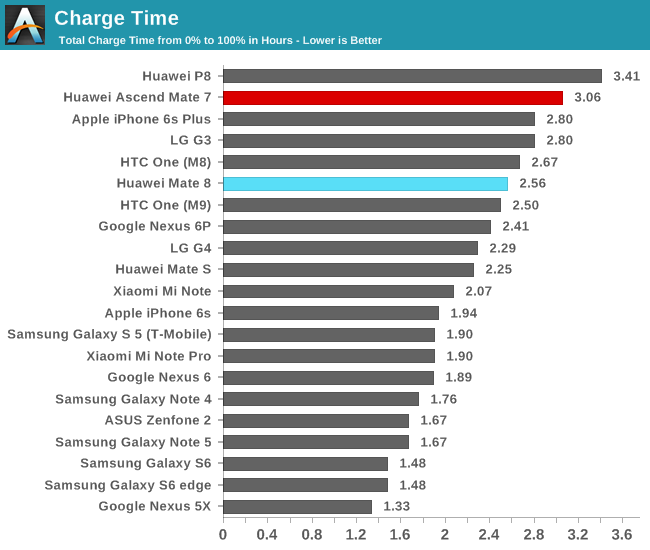
As we see in the charge graph, the Mate 8’s battery cell gets charged at up to 11.5W during the fast-charging phase, being able to reach 80% in 68 minutes around little under 40% charge for each half hour of charging. The last 20% takes up to another 70 minutes as the device switches over to trickle-charging.
While the Mate 8 ends up with total charge time of 2.56 hours, what counts is that the initial 80% of battery capacity can be charged very fast so the Mate 8 is no slouch in this metric.


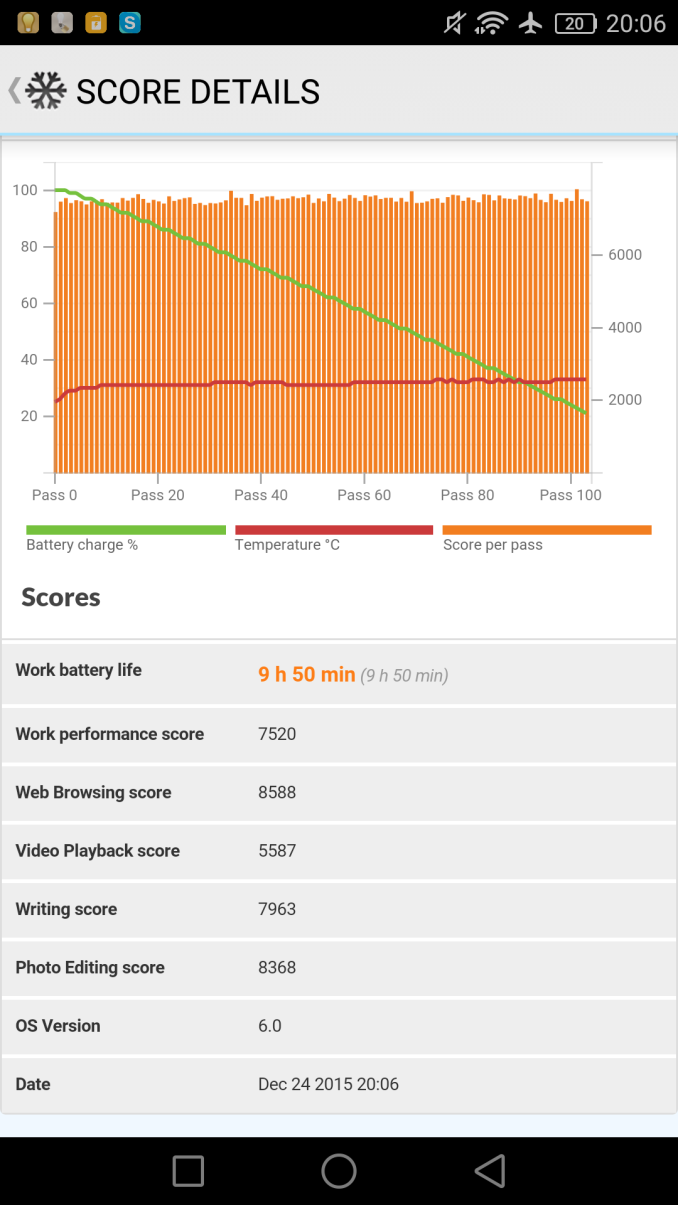
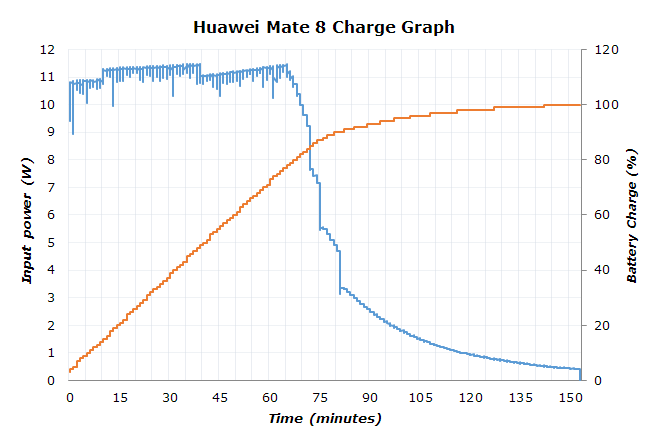








116 Comments
View All Comments
Ethos Evoss - Wednesday, January 6, 2016 - link
Problem with ipones is that prices DOESN'T go down quickly.. For this Mate 8 it will soon be cheaper .. Mate 7 released in october or november 2014 and in december I bought it just for £300 on ebaySo it will be the same with mate 8 but forget iphone 6s to be cheap man..
s.yu - Saturday, January 16, 2016 - link
Haha they say the same about Huawei in China, except they meant it the other way around, "prices go down so slow so Huawei must be good~ look at that crappy Samsung that drops 1/3 of its price in a few months~"jasonelmore - Wednesday, January 13, 2016 - link
it is quite a bit cheaper, your $700 figure is for a 128GB model, and a 128GB 6S Plus is a Grand dude. Look at the lower storage models, they are still cheaper than a iphone by 25% (even beats your toyota/hyundai comparison)MaxIT - Monday, February 15, 2016 - link
I mostly agree about your pricing point, a Huawei can't be so pricey , but your cars analogy is very poor: Hyundai and especially Toyota / Lexus (Japanese cars !) are making very good cars, even better than American's...jjj - Tuesday, January 5, 2016 - link
Mentioned this before, the SoCs memory score in Geekbench is all over the place, you haven't noticed anything off there?Other than that the SoC does ok , a bit of a pity that they don't use better NAND and WIFI since it would make a rather big difference in actual usage. Power is not ideal since it does throttle and you could have pushed further and load all 8 cores. The product should work at advertised speeds , anything less should be clearly disclosed to the consumer but considering how bad things are elsewhere , this is great.
The phone is a bit pricey, the screen is just 1080p and not quite ok colors. Too bad since it's one of the most compact designs and almost nobody is doing that now, except maybe LeTV.
Any clue on die size? Hope we see the SoC in better offerings, assuming it's not too big (and costly).
lilmoe - Tuesday, January 5, 2016 - link
"the screen is just 1080p"shhhhh, just shhhhhhhh
jjj - Wednesday, January 6, 2016 - link
I wouldn't complain about that if it was 200$ but it's not. There is a reason 1080p screens are in 120$ phones (even rather good displays like the one in the Meizu m2 Note). And it is 6 inch so you get about 367ppi vs 577 ppi in something like the S7.lilmoe - Wednesday, January 6, 2016 - link
You also get amazing battery life.....You believe that they need to add a "premium" screen to justify the asking price, when the "cheaper" parts are in fact better for the experience. I'd rather have them spend the savings on other components, like better flash, audio amplifiers with a better DAC, and a general better internal layout of components for easier repairability.
If all parts are optimum and they still save a good buck on their BoM, then good for them.
s.yu - Saturday, January 16, 2016 - link
They're selling them to presbyopic middle-aged men on the verge of retirement who only need the phones to make calls, they can't see so clearly close-up in the first place so they need huge screens and not a lot of DPI. Don't count on a better DAC, it doesn't fit their positioning, especially in China, their main market.lucam - Tuesday, January 5, 2016 - link
..and what about the iPad Pro?